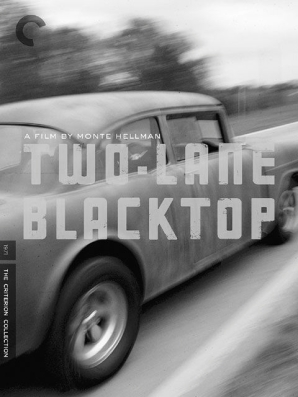





“The whole idea of the road, of going from one place to another, is essentially American.”
*
–Two-Lane Blacktop Screenwriter, Rudy Wurlitzer
Esquire magazine printed the entire screenplay in its April ’71 issue before the movie was even released and boldly declared Two-Lane Blacktop as, “The Film of the Year.” Set largely on old Route 66, which had seen better days, filming locations stretched from California to Tennessee, and the project was wrapped up in two months for mere pocket change– $950,000. And while it wouldn’t quite live up to Universal’s expectations (who did little to promote it) and become a commercial success by anyone’s standards– it would survive the test of time to become a cultural icon, and one of the most loved road films ever made. There still a lot of love for Two-Lane Blacktop– even after all these ears. Sadly, there aren’t a lot of great studio stills that have survived– finding decent pics on the internet was slim pickings. I’ve had a few squirreled away for a spell (courtesy of Performance Pontiac Magazine, go figure) and so out they now shall come– along with a few tidbits from behind the camera.
“Dennis Wilson (of Beach Boys fame) was the last one to come onboard, after I ran through every actor and some other musicians. As a matter of fact, we even met with Randy Newman. Fred Roos, the casting director, finally suggested Dennis. If memory serves, I saw Robert DeNiro, Al Pacino, and James Caan; I think I saw every young actor in Hollywood. Dennis was very easy going. The only problem was that he was having so much fun that it was hard to find him when we were ready to shoot because he was off somewhere playing all the time.” –Director Monte Hellman“With Warren Oates in the role of G.T.O., the character was so much bigger than life, while the others were really just life. He had mystery about him. He’s someone who doesn’t reveal everything the first minute you meet him. There was always something more than he was letting out. The character of G.T.O. is a lot like that and I think he was naturally able to give off those vibrations. I think he has mystery because you feel there is something deeper there, something more that you can discover. The others are what they appear to be. They’re very simple characters; they’re very simple people-particularly in the case of James’ character. He wants certain things from life that he’s unable to get because he wants other things that are interfering with it. That’s his conflict.” –Director Monte Hellman
To further the yarn-spinning quality of the character G.T.O., he deftly describes the GTO’s engine incorrectly a few times in the movie, referring to it as a 455 with Mark IV Ram Air, a Carter high-rise set up and 390 horsepower. A “Mark IV” is a big-block Chevy, the Pontiac engine didn’t come with a “Carter high-rise” but rather a Quadrajet on a cast-iron intake and no Pontiac engine at the time was rated at 390 hp. (via Performance Pontiac Magazine) But, let’s not get hung-up on the nerdy details though, it’s a movie for cryin’ out loud– and G.T.O. (Warren Oates) is clearly a little off in the head anyway.
“One (of the ’55 Chevy used for the movie) was an authentic race car and was too loud inside to record dialogue. The second had a smaller engine in it and was quieter. The last one was a stunt car, so it had a rollbar and equipment for the stunt shots. James had to do a launch in the ’55, which was shot from behind. What he didn’t know was that the transmission was mistakenly put into Reverse by whoever was in charge of the car. He was told to pop the clutch [at 6,500 rpm] and when he did, the ’55 started going backwards instead of forwards. Happily, he stopped it before running over the crew and the cameras. James said he blew up the transmission and broke the driveshaft and rear when he popped the clutch and it went backwards…” –Director Monte Hellman
I hope they never attempt to remake Two-Lane Blacktop, and neither does the man behind the masterpiece–
*
“I never see the point in remaking anything, unless it was done badly.
That’s the only reason you’d remake something.”
*
–Monte Hellman
